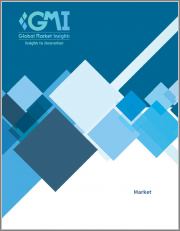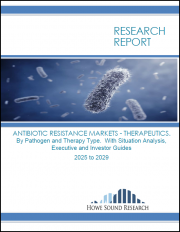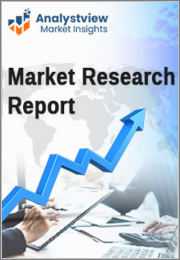
|
시장보고서
상품코드
1370609
항생제 내성 시장 : 질환별, 병원체별, 약제 클래스별, 작용기서별, 유통 채널별, 세계 예측(2023-2032년)Antibiotic Resistance Market-By Disease (cUTI, cIAI, BSI), Pathogen (E. coli, K. pneumoniae), Drug Class (Oxazolidinones, Cephalosporin), Mechanism of Action (Cell Wall, Protein Synthesis Inhibitors), Distribution Channel, Global Forecast, 2023-2032 |
||||||
항생제 내성 시장은 2023-2032년 CAGR 5.3%로 성장할 전망입니다.
항생제 오남용으로 인한 약물 내성 박테리아의 발생은 대체 치료 옵션에 대한 수요를 증가시켜 산업의 확장을 촉진하고 있습니다.
또한 감염에 취약한 세계 인구의 고령화로 인해 새로운 항생제의 필요성이 증가하고 있습니다. 의료 관련 감염에 대한 조사와 다제내성 병원균의 출현도 항생제 내성에 대응하기 위한 새로운 항균제 연구개발에 대한 투자를 촉진하고 있습니다.
정부 구상, 규제 혜택, 항생제 내성 위협에 대한 인식이 높아짐에 따라 시장 확대에 더욱 기여할 것으로 보입니다.2022년 11월, 유엔의 FAO, UNEP, 세계동물보건기구, WHO는 세계 인구에 대한 항균제 내성의 심각한 영향에 대응하기 위해 "항균제 내성 다자간 파트너십 플랫폼'이라는 새로운 구상을 발표했습니다. 혁신적인 솔루션이 시급한 상황에서 항균제 내성 산업은 향후 수년간 크게 성장할 것으로 예상됩니다.
시장은 질병, 병원체, 약품 유형, 작용기전, 유통채널, 지역별로 세분화됩니다.
질병에 따라 혈류 감염 부문은 2023-2032년 5%의 CAGR을 보일 것으로 예상됩니다. 패혈증 및 혈류 감염의 유병률 증가, 의료 관련 사례 증가, 중환자 치료 환경에서 항생제 내성 병원균 증가로 인해 이 부문의 성장을 가속할 것입니다.
녹농균 병원체 부문은 2032년까지 6.5%의 CAGR을 보일 것으로 예상됩니다. 이는 이 병원균이 여러 항생제에 대한 광범위한 내성을 갖게 되면서 대체 치료법에 대한 수요가 증가하고 있기 때문입니다. 의료 환경에서 녹농균 감염 증가도 이 부문의 성장을 가속할 것으로 보입니다.
세팔로스포린 약제 클래스별 부문은 2023-2032년 6.1%의 CAGR을 보일 것으로 예상됩니다. 이는 세팔로스포린 내성 박테리아의 확산이 가속화되면서 새롭고 효과적인 치료법 개발이 필요하기 때문입니다. 의료 관련 감염 증가와 혁신적인 항균제에 대한 수요도 이 부문의 성장을 가속할 것으로 보입니다.
지역별로 보면 아시아태평양의 항생제 내성 산업은 2032년까지 5.8%의 CAGR을 보일 것으로 예상되며, 의료 서비스 접근성 증가, 인구 밀집도, 항균제 오남용 등의 요인에 의해 주도될 것으로 보입니다. 이 지역이 항생제 내성 문제를 해결하기 위해 노력하고 있는 가운데, 인식 증가, 정부의 구상, 경제 발전이 산업 성장을 더욱 촉진할 것으로 보입니다.
목차
제1장 조사 방법과 조사 범위
제2장 주요 요약
제3장 항생제 내성 시장 인사이트
- 업계 상황
- 업계에 대한 영향요인
- 성장 촉진요인
- 항생제 내성 감염증의 증가
- 새로운 항생제 치료에 대한 요구의 증가
- 신규 항생제 연구개발에 대한 투자의 증가
- 세계의 공중보건에 대한 관심과 의식의 향상
- 업계의 잠재적 리스크 & 과제
- 치료제의 고비용
- 복잡한 규제와 개발 프로세스
- 성장 촉진요인
- 성장 가능성 분석
- COVID-19의 영향 분석
- 규제 상황
- Porter의 산업 분석
- PESTEL 분석
제4장 경쟁 구도
- 서론
- 기업 매트릭스 분석
- 경쟁 포지셔닝·매트릭스
- 전략 대시보드
제5장 항생제 내성 시장 추산·예측 : 질환별
- 주요 동향 : 질환별
- 합병증성 요로감염증
- 합병증성 복강내 감염증
- 혈류감염증
- 급성 세균성 피부·피부 구조 감염증
- 지역사회 획득 폐렴
- 클로스트리듐·디피실 감염증
- 원내 세균성 폐렴
제6장 항생제 내성 시장 추산·예측 : 병원체별
- 주요 동향 : 병원체별
- 대장균
- 폐렴 간균
- 녹농균
- 황색포도상구균
- 바우만니
- 폐렴 간균
- 인플루엔자균
- C. difficile
- 페시움
제7장 항생제 내성 시장 추산·예측 : 약제 클래스별
- 주요 동향 : 약제 클래스별
- 오키사조리지논
- 세팔로스포린
- 리포그리코페프치드
- 병용요법
- 테트라사이클린
- 기타 약제 클래스별
제8장 항생제 내성 시장 추산·예측 : 작용기서별
- 주요 동향 : 작용기서별
- 세포벽 합성 저해제
- 단백질 합성 저해제
- DNA 합성 저해제
- RNA 합성 저해제
- 기타 작용기서
제9장 항생제 내성 시장 추산·예측 : 유통 채널별
- 주요 동향 : 유통 채널별
- 병원 약국
- 소매 약국
- 온라인 약국
제10장 항생제 내성 시장 추산·예측 : 지역별
- 주요 동향 : 지역별
- 북미
- 미국
- 캐나다
- 유럽
- 독일
- 영국
- 프랑스
- 스페인
- 이탈리아
- 스위스
- 기타 유럽
- 아시아태평양
- 중국
- 일본
- 인도
- 호주
- 한국
- 기타 아시아태평양
- 라틴아메리카
- 브라질
- 멕시코
- 기타 라틴아메리카
- 중동 및 아프리카
- 남아프리카공화국
- 사우디아라비아
- 기타 중동 및 아프리카
제11장 기업 개요
- ACHAOGEN, INC.
- Basilea Pharmaceutica Ltd.
- MELINTA THERAPEUTICS
- Tetraphase Pharmaceuticals, Inc.
- Theravance Biopharma
- WOCKHARDT
- Entasis therapeutics
- Paratek Pharmaceuticals, Inc.
- Seres Therapeutics
- AbbVie, Inc.
- Merck & Co. Inc.
- Pfizer Inc.
The antibiotic resistance market will grow with 5.3% CAGR from 2023 to 2032. The development of drug-resistant bacteria triggered by misuse of antibiotic medications is increasing the demand for alternative treatment options, propelling industry expansion.
Additionally, the aging global population, with a higher susceptibility to infections, is driving the need for novel antibiotics. Rising healthcare-associated infections and the emergence of multi-drug-resistant pathogens have also fueled investments in research and development of new antimicrobial agents to combat antibiotic resistance.
Government initiatives, regulatory incentives, and increased awareness about the threat of antibiotic resistance will further contribute to market expansion. In November 2022, the UN's FAO, UNEP, the World Organization for Animal Health, and the WHO announced a new initiative called the Antimicrobial Resistance Multi-Stakeholder Partnership Platform to address the escalating implications of antimicrobial resistance on the global population. Given the pressing need for innovative solutions, the antibiotic resistance industry will expand significantly in the coming years.
The market is segregated based on disease, pathogen, drug class, mechanism of action, distribution channel, and region.
Based on disease, the bloodstream infection segment will exhibit a 5% CAGR from 2023 to 2032. The increasing prevalence of sepsis and bloodstream infections, rising healthcare-associated cases, and the growing challenge of antibiotic-resistant pathogens in critical care settings will drive growth in the segment.
The P. aeruginosa pathogen segment will reflect a 6.5% CAGR through 2032, driven by factors such as the pathogen's widespread resistance to multiple antibiotics, which is driving the demand for alternative treatments. The rising incidences of P. aeruginosa infections in healthcare settings will also foster growth in the segment.
The cephalosporin drug class segment will exhibit 6.1% CAGR between 2023 and 2032, driven by the escalating prevalence of cephalosporin-resistant bacterial strains, which will necessitate the development of new and effective treatments. The rising burden of healthcare-associated infections and demand for innovative antimicrobial agents will also augment growth in the segment.
Regionally, the Asia Pacific antibiotic resistance industry will witness a 5.8% CAGR through 2032, driven by factors such as increasing healthcare access, population density, and antimicrobial misuse in the region. Rising awareness, government initiatives, and economic development will further drive industry expansion as the region addresses antibiotic resistance challenges.
Table of Contents
Chapter 1 Methodology & Scope
- 1.1 Market definition
- 1.2 Base estimates & calculations
- 1.3 Forecast calculation
- 1.4 Covid-19 impact analysis at global level
- 1.5 Data validation
- 1.6 Data sources
- 1.6.1 Secondary
- 1.6.1.1 Paid sources
- 1.6.1.2 Public sources
- 1.6.2 Primary
- 1.6.1 Secondary
Chapter 2 Executive Summary
- 2.1 Antibiotic resistance industry 360 degree synopsis, 2018 - 2032 (USD Million)
- 2.1.1 Business trends
- 2.1.2 Region trends
- 2.1.3 Disease trends
- 2.1.4 Pathogen trends
- 2.1.5 Drug class trends
- 2.1.6 Mechanism of action trends
- 2.1.7 Distribution channel trends
Chapter 3 Antibiotic Resistance Market Insights
- 3.1 Industry landscape, 2018 - 2032 (USD Million)
- 3.2 Industry impact forces
- 3.2.1 Growth drivers
- 3.2.1.1 Increasing incidence of antibiotic resistant infections
- 3.2.1.2 Growing need for new antibiotic therapies
- 3.2.1.3 Increasing investment for research and development of novel antibiotics
- 3.2.1.4 Increasing global public health concern and awareness
- 3.2.2 Industry pitfalls & challenges
- 3.2.2.1 High cost of therapeutics
- 3.2.2.2 Complex regulatory and development process
- 3.2.1 Growth drivers
- 3.3 Growth potential analysis
- 3.3.1 By disease
- 3.3.2 By pathogen
- 3.3.3 By drug class
- 3.3.4 By mechanism of action
- 3.3.5 By distribution channel
- 3.4 COVID-19 impact analysis
- 3.5 Regulatory landscape
- 3.6 Porter's analysis
- 3.7 PESTEL analysis
Chapter 4 Competitive Landscape, 2022
- 4.1 Introduction
- 4.2 Company matrix analysis, 2022
- 4.3 Competitive positioning matrix, 2022
- 4.4 Strategic dashboard, 2022
Chapter 5 Antibiotic Resistance Market Estimates and Forecast, By Disease (USD Million)
- 5.1 Key trends, by disease
- 5.2 Complicated urinary tract infections
- 5.3 Complicated intra-abdominal infections
- 5.4 Bloodstream infection
- 5.5 Acute bacterial skin and skin-structure infection
- 5.6 Community-acquired bacterial pneumonia
- 5.7 Clostridium difficile infections
- 5.8 Hospital-acquired bacterial pneumonia
Chapter 6 Antibiotic Resistance Market Estimates and Forecast, By Pathogen (USD Million)
- 6.1 Key trends, by pathogen
- 6.2 E. coli
- 6.3 K. pneumoniae
- 6.4 P. aeruginosa
- 6.5 S. aureus
- 6.6 Baumannii
- 6.7 S. pneumoniae
- 6.8 H. influenzae
- 6.9 C. difficile
- 6.10 E. faecium
Chapter 7 Antibiotic Resistance Market Estimates and Forecast, By Drug Class (USD Million)
- 7.1 Key trends, by drug class
- 7.2 Oxazolidinones
- 7.3 Cephalosporin
- 7.4 Lipoglycopeptides
- 7.5 Combination therapies
- 7.6 Tetracyclines
- 7.7 Other drug classes
Chapter 8 Antibiotic Resistance Market Estimates and Forecast, By Mechanism of Action (USD Million)
- 8.1 Key trends, by mechanism of action
- 8.2 Cell wall synthesis inhibitors
- 8.3 Protein synthesis inhibitors
- 8.4 DNA synthesis inhibitors
- 8.5 RNA synthesis inhibitors
- 8.6 Other mechanism of actions
Chapter 9 Antibiotic Resistance Market Estimates and Forecast, By Distribution Channel (USD Million)
- 9.1 Key trends, by distribution channel
- 9.2 Hospital pharmacies
- 9.3 Retail pharmacies
- 9.4 Online pharmacies
Chapter 10 Antibiotic Resistance Market Estimates and Forecast, By Region (USD Million)
- 10.1 Key trends, by region
- 10.2 North America
- 10.2.1 U.S.
- 10.2.2 Canada
- 10.3 Europe
- 10.3.1 Germany
- 10.3.2 UK
- 10.3.3 France
- 10.3.4 Spain
- 10.3.5 Italy
- 10.3.6 Switzerland
- 10.3.7 Rest of Europe
- 10.4 Asia Pacific
- 10.4.1 China
- 10.4.2 Japan
- 10.4.3 India
- 10.4.4 Australia
- 10.4.5 South Korea
- 10.4.6 Rest of Asia Pacific
- 10.5 Latin America
- 10.5.1 Brazil
- 10.5.2 Mexico
- 10.5.3 Rest of Latin America
- 10.6 Middle East & Africa
- 10.6.1 South Africa
- 10.6.2 Saudi Arabia
- 10.6.3 Rest of Middle East & Africa
Chapter 11 Company Profiles
- 11.1 ACHAOGEN, INC.
- 11.2 Basilea Pharmaceutica Ltd.
- 11.3 MELINTA THERAPEUTICS
- 11.4 Tetraphase Pharmaceuticals, Inc.
- 11.5 Theravance Biopharma
- 11.6 WOCKHARDT
- 11.7 Entasis therapeutics
- 11.8 Paratek Pharmaceuticals, Inc.
- 11.9 Seres Therapeutics
- 11.10 AbbVie, Inc.
- 11.11 Merck & Co. Inc.
- 11.12 Pfizer Inc.



















